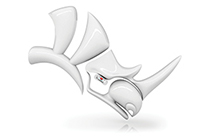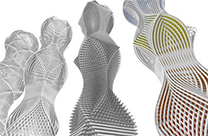Hardware and Operating Systems | Rhino for Mac
Hardware Requirements for Rhino for Mac
Please note that these requirements are different from those listed by McNeel. Our suggestions represent practical recommendations for professional users and are based on new Apple hardware specifications available at the time of writing.
The best specification for running Rhino 8 for Mac ultimately depends on what you are using Rhino for. What follows are some pointers on the various facets that can influence performance.
Please note that as well as operating hardware, the way in which Rhino models are built, and large files referenced, can make a huge difference on the speed and efficiency of working with Rhino and its associated plug-ins. Modelling efficiency and file referencing are covered extensively in our Rhino Level 2 Intermediate/Advanced course and our Rhino Core AEC Training Programme, plus we also offer Bespoke Rhino training on-site. All classes are available online.
Recommendations - Rhino 8 for Mac
Apple Hardware Guidelines - 12th March 2025
All of the products in Apple’s Mac lineup are now powered by ‘Apple Silicon’ processors, otherwise known as the ‘M’ series, the latest iteration of which is the M4. Rhino users with an Apple Silicon powered machine (M1, M2, M3 or M4) will benefit hugely by running Rhino 8 rather than earlier versions. Rhino 8 runs natively on Apple Silicon and utilises Apple’s ‘Metal’ display pipeline for the hardware acceleration of graphics intensive operations such as in-viewport manipulation and Raytrace rendering.
We’ve tested the performance increase of Rhino 8 for Mac against Rhino 7, and the results are detailed in our PDF document and the accompanying Rhino 8 Speed Improvements and Interface video.
‘Apple Silicon’ processors contain the CPU, GPU and Unified Memory (combined RAM and video memory) on one chip, and this cannot be upgraded after purchase so therefore choosing the correct specification at time of purchase is critical. In most cases too, the SSD storage is not user upgradable.
Regarding ‘new’ machines, Rhino 8 will run on all of the machines in the current Apple Mac line-up; however, the lower specification machines are only recommended for lighter use & smaller models only and in cases where the machines are supplied with 16GB of Unified Memory we’d suggest considering upgrading that amount of memory to 24GB or more. For professional users we would suggest opting for at least the ‘Pro’ versions of the processor and updating the Unified Memory to at least 36GB. The current ‘sweet spot’ for running Rhino on larger projects would be the 16” MacBook Pro and the Mac Studio. At the time of writing the majority of the range utilises the M4 chip whilst the fastest processor is the M3 Ultra as found in the Mac Studio. As navigating the various options available in the current range is not entirely straightforward, we’ve listed our recommendations on a chart showing the base specifications for the current Apple range, please find the chart at the foot of this page.
Summary - If you are looking for new Apple Hardware then our suggested practical system requirements for Rhino 8 for Mac are as follows:
Mac with M1, M2, M3 or M4 processor
At least 16 GB of Universal Memory – 32GB preferred
Supported Mac OS
- macOS 15 (Sequoia)
- macOS 14 (Sonoma)
- macOS 13 (Ventura)
- macOS 12.4 (Monterey)
If you have an existing Apple Silicon based machine, then you will see a big step-up in performance with Rhino 8 compared to earlier versions.
If you have an older high spec Intel based Mac with a dedicated GPU, you should still see a speed increase as long as your machine meets the requirements below:
- Apple Silicon Processor
- Intel Processor + Dedicated GPU
- Support for Metal API (see Apple’s list of compatible machines)
- 16 GB RAM
- macOS 14 (Sonoma)
- macOS 13 (Ventura)
- macOS 12.4 (Monterey)
Rhino 8 for Mac Speed Improvements and Interface Video
Rhino 8 Speed Test Results Document
If you require further help, or advice, please contact us. We're happy to help answer any questions related to suitable hardware for Rhino v8, for either Windows or Mac. Some customers email us their Hardware specification/quotation so we may help advise them before they make a final purchase decision, please feel free to do this.
Looking for information regarding older Mac Hardware? Then look back at our archive of advice for Hardware & Systems for Rhino for Mac.

Do you have a question for our Rhino team? Contact us now, we're always happy to help

Interested in improving your Rhino 3D skills? Then learn about our training options

Free Rhino video tutorials? Watch a selection of our Rhino tutorials here
Ready to buy?
You can purchase online at the Rhino Webstore for fast-delivery

Interested in our Rhino and Grasshopper events? Find out about upcoming events at Rhino3d.co.uk

Do you have a question for our Rhino team? Contact us now, we're always happy to help

Interested in improving your Rhino 3D skills? Then learn about our training options
Chart showing our recommendations for Mac Hardware to use with Rhino 8:
| Product | Processor | CPU Cores | GPU Cores | Unified Memory | SSD Storage | Recommendations | Rhino Suitability |
| MacBook Air 13" | Apple M4 | 10 | 8 | 16GB | 256GB | Consider Upgrading Unified Memory from 16GB* | Smaller projects |
| MacBook Air 13" | Apple M4 | 10 | 10 | 16GB | 512GB | Consider Upgrading Unified Memory from 16GB* | Smaller projects |
| MacBook Air 13" | Apple M4 | 10 | 10 | 24GB | 512GB | Smaller projects | |
| MacBook Air 15" | Apple M4 | 10 | 10 | 16GB | 256GB | Consider Upgrading Unified Memory from 16GB* | Smaller projects |
| MacBook Air 15" | Apple M4 | 10 | 10 | 16GB | 512GB | Consider Upgrading Unified Memory from 16GB* | Smaller projects |
| MacBook Air 15" | Apple M4 | 10 | 10 | 24GB | 512GB | Smaller projects | |
| MacBook Pro 14" | Apple M4 | 10 | 10 | 16GB | 512GB | Consider Upgrading Unified Memory from 16GB* | Smaller projects |
| MacBook Pro 14" | Apple M4 | 10 | 10 | 16GB | 1TB | Consider Upgrading Unified Memory from 16GB* | Smaller projects |
| MacBook Pro 14" | Apple M4 | 10 | 10 | 24GB | 1TB | Smaller projects | |
| MacBook Pro 14" | Apple M4 Pro | 12 | 16 | 24GB | 512GB | Consider Upgrading Unified Memory from 24GB* | Medium projects |
| MacBook Pro 14" | Apple M4 Pro | 14 | 20 | 24GB | 1TB | Consider Upgrading Unified Memory from 24GB* | Yes |
| MacBook Pro 14" | Apple M4 Pro | 14 | 32 | 36GB | 1TB | Yes | |
| MacBook Pro 14" | Apple M4 Max | 14 | 32 | 36GB | 1TB | Yes | |
| MacBook Pro 16" | Apple M4 Pro | 14 | 20 | 24GB | 512GB | Yes | |
| MacBook Pro 16" | Apple M4 Pro | 14 | 20 | 48GB | 512GB | Yes | |
| MacBook Pro 16" | Apple M4 Max | 14 | 32 | 36GB | 1TB | Yes | |
| MacBook Pro 16" | Apple M4 Max | 16 | 40 | 48GB | 1TB | Yes | |
| iMac | Apple M4 | 8 | 8 | 16GB | 256GB | Consider Upgrading Unified Memory from 16GB* | Smaller projects |
| iMac | Apple M4 | 10 | 10 | 16GB | 256GB | Consider Upgrading Unified Memory from 16GB* | Smaller projects |
| iMac | Apple M4 | 10 | 10 | 16GB | 512GB | Consider Upgrading Unified Memory from 16GB* | Smaller projects |
| iMac | Apple M4 | 10 | 10 | 24GB | 512GB | Smaller projects | |
| Mac Mini | Apple M4 | 10 | 10 | 16GB | 256GB | Consider Upgrading Unified Memory from 16GB* | Smaller projects |
| Mac Mini | Apple M4 | 10 | 10 | 16GB | 512GB | Consider Upgrading Unified Memory from 16GB* | Smaller projects |
| Mac Mini | Apple M4 | 10 | 10 | 24GB | 512GB | Smaller projects | |
| Mac Mini | Apple M4 Pro | 12 | 16 | 24GB | 512GB | Consider Upgrading Unified Memory from 24GB* | Medium projects |
| Mac Studio | Apple M4 Max | 14 | 32 | 36GB | 512GB | Yes | |
| Mac Studio | Apple M3 Ultra | 28 | 60 | 96GB | 1TB | Yes | |
| Mac Pro | Apple M2 Ultra | 24 | 60 | 64GB | 1TB | Yes |
